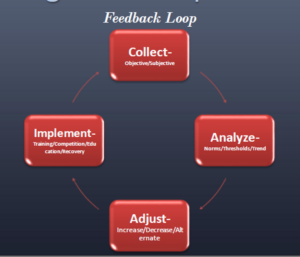Sports Science, what is it? The mission of the University of Pittsburgh Sports Science department is to optimize the human potential and growth of all Pitt student-athletes through data-informed decision-making. The sports science team is important for athletic performance because it can take all the different streams of data and put them together to tell a story. At Pitt, we split our data into four separate categories: workload (Catapult), screening (Nordbord, GroinBar, force plates), readiness (questionnaires, contact grid, sleep tracking), and performance (force plates, GymAware). When sitting in performance team meetings, members of the Sports Science Department are able to make sense of what we think we know in light of what is actually happening on the field of play.
Ultimately, the sports science team integrates technology in an effort to improve training and impact decision-making. Data drives conversations; conversations drive decisions.
Why collect all this data?
“The more you know, the more you know what you don’t know.” – Richard Feynman
Answering, Asking, and Discovering Questions
When the sports scientist/strength and conditioning coach is collecting all this data, it is easy for coaches to be overwhelmed. We try to simplify it for them by inserting the data into a feedback loop as seen below:

From this point forward, it is very important to define what the sports scientist’s key role is within the sports performance team.
What it is—Important unit of the interdisciplinary team, with a separate area of responsibilities that arose out of necessity to manage the data and its platforms. Responsibilities include (but are not limited to):
This position ultimately needs someone with time, competence, and interest.
What it isn’t—An avenue to tell coaches/staffs what to do, a desk jockey, or a fad.
A great sports scientist understands the physiology of training at a high level and makes their systems repeatable, not reliant on the same person to operate (so anyone can take over).
This is just a small taste of what was covered most recently at the CSCCA national conference in Orlando Florida. Taking the time to educate the audience around how to build out sports science, how to handle administration and sell the vision, creation of a new role, and how this position will communicate and collaborate with other performance areas. The framework for the presentation was broken down into 4 phases:
In conclusion, when building out a sports science department things to consider:

If you would like to hear more about this topic or follow up please feel free to reach out to Stephanie Mock: email: [email protected]